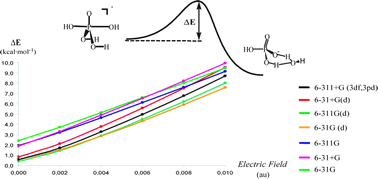Description of pentacoordinated phosphorus under an external electric field: which basis sets and semi-empirical methods are needed?†
Abstract
Phosphate transfer reactions are ubiquitous in nature and play fundamental roles in ATP

* Corresponding authors
a
Theoretical and Computational Chemistry Group, Departament de Química Orgànica Biològica, Institut d’Investigacions Químiques i Ambientals de Barcelona, IIQAB - CSIC, c/Jordi Girona 18, Barcelona, Spain
E-mail:
rcsqtc@iiqab.csic.es
Fax: +34 93 204 59 04
Tel: +34 93 400 61 11
Phosphate transfer reactions are ubiquitous in nature and play fundamental roles in ATP

 Please wait while we load your content...
Something went wrong. Try again?
Please wait while we load your content...
Something went wrong. Try again?
E. Marcos, J. M. Anglada and R. Crehuet, Phys. Chem. Chem. Phys., 2008, 10, 2442 DOI: 10.1039/B719792F
To request permission to reproduce material from this article, please go to the Copyright Clearance Center request page.
If you are an author contributing to an RSC publication, you do not need to request permission provided correct acknowledgement is given.
If you are the author of this article, you do not need to request permission to reproduce figures and diagrams provided correct acknowledgement is given. If you want to reproduce the whole article in a third-party publication (excluding your thesis/dissertation for which permission is not required) please go to the Copyright Clearance Center request page.
Read more about how to correctly acknowledge RSC content.
 Fetching data from CrossRef.
Fetching data from CrossRef.
This may take some time to load.
Loading related content
